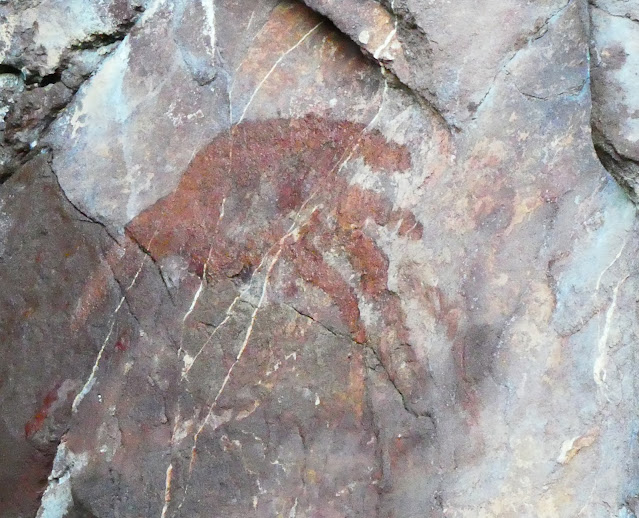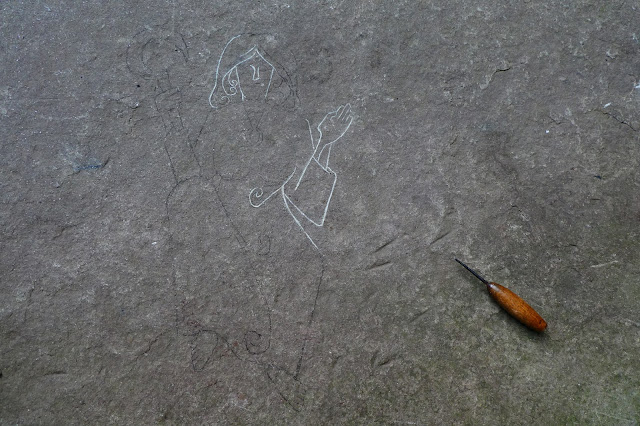The Valkyrie-Diptych Narrative Framework of the 'Saga'
In a work that is devoted to deconstruction, it seems ironic to be writing of a structuralist underpinning to one significant part of the Saga, but it is a framework so obscure that it needs some elucidation, and was written into the narrative as a direct reference to Old Norse and Old English scholarship itself.
I came across the theory of the “Valkyrie-diptych narrative structure” in the 2013 paper on the alleged presence of Valkyrie-figures in Old English literature, by Philip A. Purser, which I studied at length last summer and which influenced greatly the writing of the early form of the Saga at that time. Whilst I later took much issue with Purser's interpretations, I was intrigued enough by this narrative framework that it's worth quoting Purser's paper in full:
- "In 1984, Helen Damico forwards the notion that a type of narrative structure, which gained great currency in twelfth- and thirteenth-century Icelandic and Scandinavian literature, was represented in Anglo-Saxon England prior to the mid-eleventh century.2 Damico calls this unique narrative structure the “Valkyrie-diptych narrative structure,” and remarks that it is a narrative type defined by the roles played by two, opposing Valkyrie-figures within the narrative, who, being disparate in physical form and motivation toward the narrative’s hero, occupy disparate roles and strive to accomplish opposing goals as regards the fate of the tale’s protagonist-hero.3 The Valkyrie-diptych is a subgenre of the heroic literature that, prior to Damico, was considered not to have existed outside the Old Norse corpus. Damico begins her argument by noting that “in Old Norse literature, two distinct, antagonistic perceptions of Valkyries essentially exist: they are seen as fierce, elemental beings, and as benevolent guardians.”4 One Valkyrie figure functions as savior to the living hero,and the other is his would-be executioner. Damico furthers her claim by showing how Norse skalds employ the two “antagonistic perceptions of Valkyries” jointly within a single text to create a Valkyrie diptych, noting that “occasionally, the Old Norse documents juxtapose the sinister battle-demon with the radiant, courtly figure” in order to complicate the narrative and heighten the narrative tension toward the hero’s quest.5 By establishing the parameters by which the “sinister battle-demon” and the “radiant, courtly figure” of the Old Norse Valkyrie-diptych may be understood, Damico lays the foundation for her assertion that the Old English characters of Wealhþeow and Grendel’s mother may also be read as figures within the diptych paradigm..." (Purser, pp. 117-8)
In the sense that Womba plays the traditional hero role (albeit unwillingly, and at times unwittingly), she is nonetheless engaged with, and acted upon by, the two opposing forms of the classical Valkyrie-figure: in her beneficial, "courtly" aspect as Gerthild (though in a much-degraded form: when they first meet, Gerthild's occupation is a tavern owner, serving meat and drink to visiting mercenaries, but the function of serving drinks to warriors is identical to the beneficial function of the Old Norse Valkyrie in Valhalla) - and in her violent, aggressive form as the "battle-demon" Fyrfax (who is herself ultimately a dualistic figure, but that's another matter). Fyrfax's actions affect Womba personally long before the two get to meet on the field of Ealdenward - her killing of Womba's uncle is brought to her as news early on, setting up that path of fate - but also via the vow of blood-vengeance for kinslaying, a code of conduct which drives much of the action in the Norse Sagas, as well as Beowulf (not least of which is Grendel's mother's obligation to avenge her son's death; which she does, and in truth that ought to have been the end of the matter, but it would have made for a rather truncated epic - a subtext which is itself echoed in Fyrfax's determination to avenge her husband, which she does in part, by slaying Gerthild, the beneficial one, just as she once "slew" the glorious, beautiful younger form of her own self). As Gerthild in her rejuvinated form at the final battle, the Valkyrie-protector saves the hero from her "would-be executioner", Fyrfax; her spear checking the tyrant queen's sword blow aimed at the unconscious Womba. And when Gerthild insists that Womba swear an oath of vengeance for her slain uncle, she does so whilst holding aloft a drinking horn - an act mirrored in Beowulf (what Purser describes as "the sacerdotal moment in which Wealhþeow presents Beowulf with the ale-horn and his making a boast over the horn as she tasks him with his sacral duty...")
In summarizing the function of the 'good' figure, Purser explains: "The role of the beneficent Valkyrie figure in the Old Norse form of the diptych is three-fold. This war-woman tasks the hero with his monster or villain-slaying quest, most often by offering him a mead-horn over which he will pronounce his oath of monster-slaying; she provides supernatural aid or advice to him prior to or during his mission; and she often weds the hero or functions, in a more or less concupiscent manner, as his bride..."
Whilst not acting as a 'bride' in any traditional sense, in the subversive text of the Saga Gerthild and Womba do find themselves in an intense though Platonic queer relationship to the point that they become inseparable friends. The only point where Womba leaves her is in her descent into her own Jungian Id, through the Grendelmere-like waters of Yeow to seek the remains of her father, and to learn her fate ahead of the final battle. This act is for Womba and Womba alone, but at all other times, Gerthild acts as her literal and physical guardian, until the fateful moment when she is no longer essential.
Purser's primary reference: Helen Damico. “The Valkyrie Reflex in Old English Literature,” New Readings on Women in Old English Literature. eds. Helen Damico and Alexandra Hennessey Olsen. Bloomington, Indiana University Press, 1990. I cite Purser at length as have yet been unable to obtain the above text.


Comments
Post a Comment